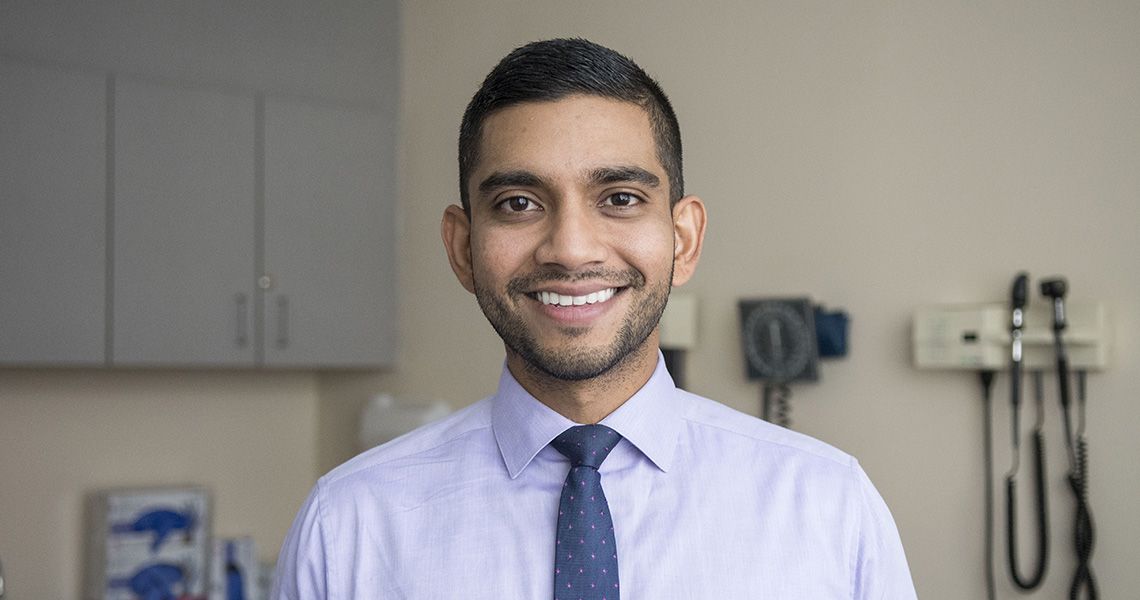Skin cancer is one of the most common cancers, but it’s also the most preventable. May is Skin Cancer Awareness Month, and it’s a good time to brush up on skin cancer basics as well as dive into deeper and less common information. Here, Vishal Patel, MD, associate professor of dermatology at the George Washington University (GW) School of Medicine and Health Sciences, director of dermatologic surgery at the GW Medical Faculty Associates (MFA), and director of cutaneous oncology at the GW Cancer Center, walks us through specific awareness and prevention strategies.
Can patients of all skin tones get skin cancer? How might skin cancer appear on different tones?
Patel: While skin cancer is most common in patients with lighter skin, people of all skin tones, including brown and black skin, can get skin cancer. Even if you never sunburn, you can get skin cancer. Skin cancer on darker skin tends to have pigmentation so lesions may look like other dark moles or other benign spots. But if the lesion is different than your other spots, painful, bleeding, or changing, it should alert you to have it evaluated.
What is the ABCDE method for melanoma?
Patel: The ABCDE method is a set of guidelines to help identify potential lesions suspicious for melanoma. ABCDE stands for:
A – Asymmetry: One half is unlike the other half.
B – Borders: Irregular, scalloped, or poorly defined border
C – Color: Varied from one area to another (shades of tan or brown, black, red, white, or blue)
D – Diameter: Diameter of 6 mm or larger (the size of a pencil eraser)
E – Evolution: Looks different from the rest or is changing in size, color, or shape.
What unexpected places can skin cancer appear?
Patel: Skin cancers can occur anywhere! It is most common on sun-exposed areas, but it can also occur in the mouth, in the eyes, on the hands and feet, on the nails, and even on the genitalia. Although these sites are rare, any skin surface can become altered or damaged, turning it into a malignancy.
What's the best way to perform a skin self-exam?
Patel: A skin self-exam is best done in front of a full-length mirror with good lighting. A good time to do it is after a shower or bath. You can use a hand-held mirror to look at areas that are hard to see, such as the backs of your thighs. A spouse, partner, or close friend or family member may be able to help for hard-to-see areas, including your back or scalp. The first time you examine your skin, spend time carefully going over the entire surface and getting used to the general pattern of your moles, blemishes, freckles, and other marks on your skin. Over time, you will get used to noticing any new lesion or potential small changes in the lesions. If you have a concerning lesions, be sure to make an appointment to show your doctor.
How can you prevent skin cancer? For example, should you wear sunscreen year-round or on cloudy days?
Patel: Moderation is key, like in any aspect of life! Limiting exposure to the sun during peak sun hours (10 a.m. to 3 p.m.) by seeking shade and avoiding constant, long periods of direct sun are the easiest ways to help prevent skin cancer. Sunscreen use is important as well – not just on sunny days, but also cloudy or snowy days as UV radiation can penetrate through clouds or reflect off snow. Use a broad-spectrum sunscreen that filters both ultraviolet A (UVA) and ultraviolet B (UVB) rays and offers a sun protection factor (SPF) of 30 or higher every day. Make it part of your regular skin care routine as many moisturizers now have sunscreen built into them. And don't forget to reapply as sunscreen generally lasts for about two hours before needing to be reapplied, and that does not include if you are sweating or in water. Lastly, if you don't love to apply sunscreen, consider UV protective clothing, sunglasses with UV protection, as well as a wide-brimmed hat.
How does GW care for patients with skin cancer? What treatment options are available?
Patel: The GW Cancer Center’s Cutaneous Oncology program provides highly specialized care for all types of active skin cancers, as well as care for patients with suspected skin cancers who need diagnostic testing or surveillance.
Our personalized and multidisciplinary approach allows patients to have access to a wide variety of physicians during their visit, including:
- Dermatologists, who evaluate and monitor suspicious lesions and help to manage the side effects of chemotherapy and radiation therapy;
- Dermatopathologists, who evaluate tissue slides of possible cancerous lesions;
- Dermatologic surgeons and surgical oncologists, who work together to most effectively remove malignant lesions using cutting-edge surgical therapies like Mohs micrographic surgery;
- Radiation oncologists, who add radiation therapy to bolster cure rates;
- Medical oncologists, who add chemo and immunotherapy to treat more advanced skin cancers; and
- Genetic counselors, who help patients understand and manage their risk for cancer.
To make an appointment with a dermatologist, visit GW Dermatology or call 202-741-2600.




